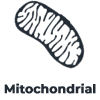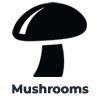BLACK HOOF | CHAGA | CORDYCEPS | LION'S MANE | MAITAKE | PORIA | RED REISHI | SHIITAKE | TURKEY TAIL | WHITE JELLY
The Ultimate Guide To The Best Mushroom Extracts
Mushroom Extracts Covered In This Article
The History Of Mushroom Extracts
Humans have used mushroom extracts for centuries. The oldest known human mummy, dated at over 4,000 years old was found buried with a kit containing remnants of Piptoporus betulinus, a mushroom still used in a few practices today. The ancient Egyptians were one of the first people to use mushrooms and associated mushrooms with immortality. Mushrooms were eaten regularly among Pharaoh and members of the royal family. They even referred to mushrooms as “sons of the gods” and believed that the god of storms known as ‘Set’ spawned mushrooms by hurling lightning bolts covered in mushroom seeds to Earth. Mushrooms were used in Ancient China as well, including the Reishi fungi, were used in tonics and reserved for royalty. Practices in Ancient China reserved special mushrooms for royalty, such as Red Reishi fungi, and were used to make tonics to promote health. Although we may no longer believe in the mythology behind the origin of mushrooms on Earth, modern research has dissected the benefits and uses behind these mushrooms and revealed the amazing compounds believed to be responsible for various mushroom benefits.
Although people have been taking mushrooms for their various benefits for thousands of years, the modern practice of extracting beneficial compounds from plants began in 1928 when Alexander Flemming discovered penicillin. Ever since, dozens of beneficial compounds have been discovered, identified, and extracted or synthesized from mushrooms. Let’s take a look at some of the common mushroom extracts and their benefits.
BLACK HOOF MUSHROOM
What is Black Hoof Mushroom?
Black hoof, or Phellinus linteus, has been used for centuries throughout China, Korea, and Japan. True to its name, black hoof mushrooms are shaped like a hoof, and bitter in taste. Phellinus linteus grows naturally in trunks of willow, paper mulberry, and elm trees that are more than 100 years old, and grows for minimum 30 to 40 years to make a fruiting body able to be used for a variety of applications. Because of this, P.linteus is very rare in nature. In addition to the natural rarity of Black hoof mushroom, the perceived Black hoof mushroom benefits make this mushroom highly sought after.
Black hoof mushroom has a history of being used quite regularly in Asian cultures for centuries. Some cultures would make a Black hoof mushroom tea as it was believed to help bolster one’s immune system and digestive health. Modern science has even revealed that Black hoof mushroom benefits extend to supporting healthy metabolic function as well.
Phellinus linteus research found that a compound known as Hispolon occurs naturally in Black hoof mushroom which makes the list of black hoof mushroom benefits even more interesting as Hispolon was found to support balanced inflammation levels in rats in various trials. Hispolon was even found to promote apoptosis in harmful cells in select in vitro studies. Apoptosis is the natural process of programmed cell death that occurs in multicellular organisms. Black hoof mushroom even contains beta glucans which are known to help support immune system health! Furthermore, Black hoof mushroom benefits also extend to brain and exercise benefits. Small scale experiments found that a Black hoof mushroom supplement appeared to carry neuroprotective effects and promote endurance during physical activity.
This mushroom is fairly unknown and not the most popular yet, but we feel that Black hoof mushroom doesn’t get enough credit for its unique and versatile effect profile! In our opinion, this makes Black hoof mushroom a must have mushroom supplement for anyone looking for a really well rounded mushroom supplement.
More Black Hoof Mushroom From Nootropics Depot
CHAGA MUSHROOM
What is Chaga Mushroom?
The Chaga mushroom, scientifically known as Inonotus obliquus, looks more like burned wood than a traditional mushroom. Chaga mushroom produces a wood-like growth called a conk and grows on birch trees all over the world, including Korea, Russia, and northern areas of the United States. The Chaga conk is dark in color, with an appearance resembling burnt wood. This dark colored exterior is due to its high melanin content, while the inside of the chaga mushroom is a bright orange.
Chaga is also unique since it does not form traditional fruiting bodies when it grows. Instead, Chaga forms sclerotia, or masses of mycelium. The name chaga is a Latinisation of the Russian name 'чага' which is purportedly derived from the word for the fungus in Komi-Permyak, the language of the indigenous people in the Kama River Basin, west of the Ural Mountains.
Chaga has been used in Northern European and Russian folk remedies for centuries and was traditionally made into a chaga tincture or chaga tea. Research suggests that Chaga can potentially provide a variety of health benefits, including supporting our immune system. This may explain the extensive traditional practices of using Chaga for immune health. What also makes Chaga an interesting mushroom is that the Chaga fungus is rich in essential nutrients like Vitamin D, fiber, Potassium, Calcium, Magnesium, and Manganese.
If all that wasn’t exciting enough, you might be excited to know that Chaga Extract may also promote optimal cellular function. Like its sibling black hoof mushroom, it produced no or low toxicity in tested normal cells. This makes it one of the best mushroom supplements to promote optimal cellular function. Chaga extract has also been shown to scavenge free radicals, making chaga great for supporting balanced levels of oxidation. Although there is still ongoing research aiming to prove these chaga benefits beyond anecdotal and textual evidence, we consider Chaga to be another underrated but versatile mushroom.
More Chaga Mushroom From Nootropics Depot
CORDYCEPS MUSHROOM
What is Cordyceps?
The Cordyceps genus comprises several species of fungi described as endoparasitoids, meaning they essentially grow and feed on other organisms; mainly insects, arthropods, and sometimes other fungi. “Cordyceps” comes from the Greek word kordyle, roughly translating to “club head,” which describes the elongated shape of the fruiting body. The two most common species used today are Cordyceps sinensis and Cordyceps militaris. C. sinensis is traditionally only found in the mountainous regions of the Himalayas, and is highly sought after in traditional Chinese practices for its rarity and perceived value, but is very difficult to cultivate and hard to find in the wild. C. militaris is more widely distributed, can be cultivated and grown in controlled environments, and also have been reported to contain higher levels of active ingredients, such as Cordycepin, than C. sinensis.
The use of Cordyceps throughout traditional Chinese and Tibetan practices suggest that the mushroom contains several biochemical compounds. In fact, Cordyceps militaris mushrooms contain several phytonutrients, or plant compounds that may have some effect on human health or body. One of the desired phytonutrients in cordyceps is cordycepin, or 3'-deoxyadenosine. Cordycepin is the main chemical component found in Cordyceps militaris and a powerful compound with a wide range of potential beneficial properties such as the potential to support a positive emotional outlook, support cellular function and promote energy.
Cordyceps is used by many looking for an energy boost. If you look at the full name of cordycepin, 3'-deoxyadenosine, you can see a possible reason for why that is. Cordycepin, being a derivative of the nucleoside adenosine, can participate in some similar biochemical processes, and boost ATP levels. Your body uses ATP, or adenosine triphosphate, for cellular energy. In addition to cordycepin, Cordyceps is also rich in polysaccharides which are a type of carbohydrate made of a string of monosaccharides. Polysaccharides may have a variety of roles in the human body, particularly relating to the digestive system and various immune functions. Cordyceps militaris is also known to carry beta-glucan polysaccharides, which are known for their immune system promoting benefits.
Cordyceps militaris studies suggest that the high amount of polysaccharides play a role in several Cordyceps benefits and uses such as supporting balanced oxidation levels. In other animal studies, Cordyceps supplements were shown to increase cytokine synthesis. Cytokines are proteins that have been found to have a significant role in cell signaling and immune system function, and also may contribute to several Cordyceps benefits.
Among these other Cordyceps mushroom benefits, Cordyceps may also reduce the buildup of lactic acid, the compound your muscles produce when fatigued. Some research even found that cordyceps may also help support a healthy metabolism. Cordyceps mushroom is a serious contender for one of the most amazing mushrooms out there, which is no wonder why it is so prized in traditional Chinese practices.
More Cordyceps Mushroom From Nootropics Depot
LION'S MANE MUSHROOM
What is Lion's Mane Mushroom?
Lion’s mane mushroom belongs to the ‘tooth fungi’ group and is sometimes called bearded tooth mushroom, hedgehog mushroom, or bearded tooth fungus. Lion’s mane mushroom grows naturally on hardwoods and can be found in the tree dense forests of Europe, North America, and Asia. The name Lion’s mane is attributed to its unique shape of long dangling spikes that grow in clusters with likeness to a Lion’s mane. Lion's Mane mushroom is scientifically known as Hericium erinaceus and was once a prized mushroom reserved exclusively for the Chinese royal family. Today, Lion’s mane mushroom is used quite often in Chinese vegetarian cuisine as a substitute for lamb or pork.
Research of Lion’s mane extracts demonstrate that Lion’s mane mushroom is rich in several polysaccharides. Several studies have even found that oral consumption of Lion’s mane mushroom may promote cognitive function. This alone makes Lion’s mane a very popular mushroom in the nootropics community and one of the more popular nootropic mushroom extracts on the market.
More Lion's Mane Mushroom From Nootropics Depot
MAITAKE MUSHROOM
What is Maitake Mushroom?
Grifola frondosa, or Maitake mushroom is a unique polypore mushroom that can be found growing in China and the northeastern parts of North America and Japan. This mushroom commonly grows at the bases of trees and particularly in clusters, which lends it the nicknames hen of the woods mushroom or ram’s head mushroom. You can find Maitake mushroom growing in the northeastern parts of the United States as well as many parts of Japan.
Maitake mushroom is also another highly regarded mushroom in traditional Chinese practices. It is believed that Maitake mushroom has a unique ability to balance out body systems. This belief has been widely believed at face value and it wasn’t until recently that Maitake mushroom studies discovered what actually may be behind all the various maitake benefits. Maitake mushrooms are rich in vitamins and minerals like calcium, magnesium, potassium and vitamins B2, niacin, and D2. In vitro studies have found that Maitake mushroom appears to promote optimal cellular function and may also promote metabolic function. Ancient Chinese texts also purported that Maitake mushroom carries immune health benefits.
For centuries this has been a widely held belief until recent Japanese studies looked into what may be a source of Maitake mushrooms immune system benefits. Their findings determined that Maitake mushrooms are rich in beta glucans. The knowledge of beta glucan benefits on our immune system is nothing new as scientists have been studying the benefits of beta glucans on immune health for decades. However, research on beta glucans in the United States and Europe focused on beta glucans isolated from Saccharomyces cerevisiae while research in Japan focused on mushroom-derived beta glucans.
Maitake is a fantastic mushroom and modern research has found that Maitake can actually provide some cognitive support. Recent findings found that Grifola frondosa interacts with AMPA receptors, which may produce cognitive benefits. AMPA receptors glutamate receptors that mediate synaptic transmissions within the central nervous system. AMPA receptors can be found in several areas of the brain and are the most common receptor in the nervous system. Interestingly enough, AMPA receptors have been found to promote cognitive health and overall brain function.
Additionally, some interesting discoveries were made when looking into Grifola frondosa interactions with AMPA receptors. Maitake mushrooms also appears to have a direct interaction with AMPA receptors according to some studies. Maitake mushroom behaved as an agonist to AMPA receptors, thus promoting healthy emotional outlook. Researchers hypothesize that this may be caused by the fact that Maitake mushroom contains a specific type of beta glucan known as Proteo-β-glucan. This specific type of beta glucan is believed to be responsible for these effects.
More Maitake Mushroom From Nootropics Depot
SHIITAKE MUSHROOM
What is Shiitake Mushroom?
You may know Shiitake mushroom as a fragrant and delicious addition to a meal, but Shiitake mushroom has an interesting history of over thousands of years and is known to have its own unique set of benefits. Lentinula edodes, or as it is more commonly known, Shiitake mushroom has been used in several Traditional Chinese practices for centuries. Shiitake mushrooms have long been used in China and they’re also part of the traditional practices of Japan, Eastern Russia, and Korea. Even as far back as the 12th century, people grew Shiitake mushrooms in the mountains of central China. Cultivators would use plant spores from fallen trees and wood logs to speed up the growth of Shiitake mushroom in the region.
Unlike most mushrooms, many people find Shiitake mushroom to be savory and delicious, making oral consumption an enjoyable task and taking advantage of Shiitake mushroom benefits that much sweeter. Various research has been conducted on Shiitake mushroom over the last several years to discover the extent of Shiitake mushroom benefits. Japanese studies in the 1970’s discovered that a compound known as Lentinan appeared to be responsible for Shiitake mushroom benefits. Some of these studies found that Lentinan may help promote feelings of well being, support immune system function and support cellular health.
Animal research on Lentinan found that Lentinan interacts with AMPA receptors and may promote feelings of well being. Several rat trials were conducted to determine Lentinan’s impact on AMPA receptors and results pointed researchers to believe Lentinan’s interaction with AMPA receptors appears to be the source of mood and cognitive promoting effects. Even as more research is ongoing, Lentinan is currently used in some wellness practices within China and Japan.
Another pretty unique trait about Shiitake mushroom is that it is also widely researched for its oral health benefits. Some research looked at bacteria in the mouth and found that shiitake mushroom supplementation appeared to promote the existence of good bacteria among subjects. Although this trend appears to be consistent, further studies are needed to identify and isolate other active ingredients that may play a role in these diverse shiitake mushroom benefits
Small animal studies were conducted to see the effects of diets containing shiitake mushroom. Results indicated that Shiitake mushroom enriched diets appeared to promote metabolic function and support cardiovascular function in rats. Even though findings from these trials support claims from traditional Chinese practices, modern studies on Shiitake mushroom benefits are still ongoing.
More Shiitake Mushroom From Nootropics Depot
PORIA MUSHROOM
What is Poria Mushroom?
Wolfiporia extensa is a species in the polyporaceae family, and is a wood-decay fungus that is most prized for its sclerotium. The sclerotium, which is a mass of the fungus’ mycelium, resembles a small coconut and has been used in traditional Chinese practices for centuries. It's used extensively in traditional Chinese practices as a way to calm the mind. In fact, Poria cocos is arguably one of the most commonly used mushrooms in traditional Chinese practices. There are several known Wolfiporia cocos mushroom uses in traditional Chinese practices such as promoting cellular and organ health to supporting cognitive abilities as well.
Poria mushroom’s popularity in traditional Chinese practices has spurred research into researching what may be behind this interesting profile of Poria mushroom benefits. Poria cocos mushroom was found to contain a high amount of bioactive compounds such as a mix of triterpene derivatives, monosaccharides, and a few unique amino acids. These compounds are believed to have a synergistic behavior and are said to be responsible for producing a diverse profile of Poria cocos benefits that promote whole body health and may also help promote brain health and cognitive functioning.
Wolfiporia extensa research found Poria cocos mushroom to be especially rich in triterpenoids, a class of compounds that may help support balanced levels of oxidation. A particular triterpenoid compound known as Pachymic acid has been of interest in scientific Poria studies. Research has found that Pachymic acid appears to support optimal cellular function. Select trials were able to notice a correlation between wolfiporia extensa supplementation and these particular Poria benefits. Some results were even convincing enough to warrant further scientific investigation and research. Further research also discovered that Poria cocos mushroom is rich in beta glucans, which may help promote immune health.
More Poria Mushroom From Nootropics Depot
RED REISHI MUSHROOM
What is Red Reishi Mushroom?
Ganoderma lucidum, also known as Lingzhi mushroom or Red Reishi mushroom, are soft, flat, and feature a red, kidney-shaped cap. Red Reishi Mushrooms have been used for over 2,000 years in Chinese practices. Ganoderma lucidum mushrooms are one of the oldest mushrooms known to be used, and are believed to be first used in Chinese practices during the Han Dynasty around 206 BC-220 AD. Hundreds of early Chinese texts refer to red reishi as the "mushroom of immortality" or "elixir of life." The generic name Ganoderma derives from the Greek ganos γανος "brightness; sheen", hence "shining" and derma δερμα "skin". It lacks gills on its underside, and releases its spores through fine pores, leading to its morphological classification as a polypore.
Uncovered classical Chinese medical texts even contain information about red reishi mushrooms and red reishi mushroom benefits. Red Reishi Mushroom Extract has been studied for years and has been found to have various purported red reishi benefits from cognitive support to promoting immune system function.
Ganoderma lucidum mushroom research has shown that Red Reishi benefits can be credited to several compounds. One of them being ganoderic acids. Ganoderma lucidum mushroom synthesizes ganoderic acids which share similar molecular structure to steroids. Other compounds include polysaccharides such as coumarin, mannitol, alkaloids, and of course, beta glucans.
Red reishi also contains other compounds including polysaccharides which may be crucial in some of the red reishi mushroom benefits. These polysaccharides such as coumarin, mannitol, alkaloids, and most notably beta glucans can extend to immune and respiratory benefits. To further add to the cocktail of bioactive red reishi compounds, Red Reishi Mushrooms contain also contain a group of proteins called fungal immunomodulatory proteins (FIPs) which were found to assist bodily immune system function. FIPs were even found to support cellular function and assist the overall immune response system. All these compounds have been found to provide various Red Reishi health benefits individually, but all these naturally occurring beneficial compounds exist in Red Reishi mushroom. The science speaks for itself. Red Reishi’s rich portfolio of bioactive constituents make Red Reishi one of our favorite mushrooms and a great multi-use mushroom supplement.
More Red Reishi From Nootropics Depot
TURKEY TAIL MUSHROOM
What is Turkey Tail Mushroom?
Trametes Versicolor, commonly referred to as turkey tail mushroom, gained its name from its resemblance to the colorful tail plumage of a wild turkey but is also known as Coriolus versicolor and Polyporus versicolor. It has been used traditionally for its benefits as a tonic for thousands of years. The top surface of the cap shows typical concentric zones of different colors. The cap is rust-brown or darker brown, sometimes with blackish zones. The pore surface is whitish to light brown, pores round and with age twisted and labyrinthine.
Trametes versicolor has had its fair share of use in the repertoire of traditional Chinese practices but it was not until modern research on turkey tail mushroom were we able to find out exactly why these ancient practices held turkey tail mushrooms in such high regard.
Turkey tail mushroom contains two pretty significant compounds for boosting immune system function known as Polysaccharide K (PSK) and Polysaccharide-peptide (PSP). Animal studies and lab research conducted tests on the impact of PSK on the immune system, specifically looking at the impact on immune cells called natural killer cells.
Research evaluating Turkey tail mushroom benefits concluded that PSK may help stimulate these Natural Killer cells but we are still unsure if this is a direct or indirect effect. Despite the lack of definitive evidence, PSK from Trametes versicolor has been highly utilized in Japan to promote and support cellular function and immune function for decades. '
An in vitro study found that PSP elevated monocyte content. Monocytes are a form of leukocyte, or white blood cell that help promote immune system function and reinforce our bodies’ natural defenses. Additionally, PSP extracted from turkey tail mushroom appeared to support balanced inflammation levels against control groups. Interestingly enough, Turkey tail mushroom health benefits may extend to digestive health as well. Studies on PSP from Trametes versicolor determined that PSP promoted digestive health and promoted other gut health benefits.
When it comes to our immune system, beta glucans are fantastic for promoting immune system strength overall. What makes Turkey tail stand tall above the rest is its ability to help promote monocyte content through PSK and PSP. This is a trait unique to Turkey tail mushroom and makes it a great mushroom supplement to take regardless of whether you’re sick or not. When it comes to fighting off the common cold, Turkey tail mushroom’s high beta glucan content and immune system reinforcement make it the obvious weapon of choice.
More Turkey Tail Mushroom From Nootropics Depot
WHITE JELLY MUSHROOM
What is White Jelly Mushroom?
Tremella fuciformis, also known as White jelly mushroom for its soft and translucent appearance, is a tropical mushroom that grows on hardwoods after a storm. White jelly mushrooms are one of the most popular mushrooms used in traditional Chinese practices and in cuisine. White jelly mushrooms can be found growing all over the world in warm climates, especially in the tropics, where it can be found on the dead branches of broadleaf trees. Tremella fuciformis was first described in 1856 by English mycologist Miles Joseph Berkeley, based on collections made in Brazil by the botanist and explorer Richard Spruce.
Tremella fuciformis mushroom has an extensive history of being used for skin health in traditional Chinese practices. Even today, many people today still incorporate Tremella fuciformis into their skin care routines. Traditional applications of tremella fuciformis in skin care routines involved topically applying white jelly mushroom to one’s skin.
Although it was historically applied topically, white jelly mushroom does not need to be topically applied to take advantage of Tremella fuciformis health benefits. According to Chinese traditional uses, eating White jelly mushroom for skin health benefits was encouraged. Many people believed that if white jelly mushroom was eaten regularly, facial freckles may lighten.
Oxidative stress is one of the major stressors to our skin health. Studies discovered that oxidative stress may slow down the skin’s regenerative processes and tends to target and damage skin fibroblasts. Skin fibroblasts promote collagen synthesis and assist in supporting skin health as a whole. When skin fibroblasts become damaged, they may create higher concentrations of enzyme MMP-1, an enzyme known to reduce collagen levels. White jelly mushroom research also revealed that skin fibroblasts are sensitive to hydrogen peroxide, which occurs naturally in our bodies. Research revealed that a White jelly mushroom supplement appeared to diminish oxidative damage inflicted on skin fibroblasts from hydrogen peroxide. White jelly mushroom appeared to support collagen levels in skin by reducing this type of damage.
Other studies found that White jelly mushroom extract seems to interact with another enzyme that promotes skin health. This enzyme, known as SIRT1, is an enzyme that appears to exert several beneficial effects on a few different types of cells throughout the body. Results from White jelly mushroom studies observed that by activating SIRT1, White jelly mushroom may help protect our skin from oxidative stress that may come from reactive oxygen species like, for example, hydrogen peroxide. SIRT1 levels appear to diminish at a fast rate as we get older which leaves our skin with a weakened protection system. Ultimately, since White jelly mushroom may up-regulate and activate SIRT1, and also may reduce MMP-1, it may be a highly beneficial two pronged skin health supporting mushroom supplement.
The Wonderful World of Mushrooms
With their use spanning thousands of years, and the recent scientific push to understand the compounds in them that give their varied effects, it's no surprise mushroom extracts are a big part of many people's supplement regimen. Nootropics Depot offers a wide range of mushroom extracts, in powder and capsules, including two sample packs. If you’re a beginner, consider the common sample pack (featuring cordyceps, lion’s mane, red reishi, and maitake) or the uncommon sample pack (featuring chaga, black hoof, poria, turkey tail, and white jelly) to figure out what works best for you.
More White Jelly Mushroom From Nootropics Depot
DISCLAIMER: Always consult with a qualified health physician before taking any new dietary supplement. These products are not intended to diagnose, treat, cure, or prevent any diseases. These statements have not been evaluated by the Food and Drug Administration.
READ MORE NOOTROPICS DEPOT BLOGS









Ayurveda | Adaptogens | Amino Acids | Choline Supplements | Fitness Supplements | Immune Support | Metabolism Supplements | Mushroom Extracts | Natural Plant Extracts | Natural Nootropic Capsules | Natural Pain Support | Patented Nootropic Extracts | Sleep Support Supplements | Softgels | Solutions + Sublinguals | Enteric Coated Tablets | Nootropic Samples
About Nootropics Depot
Nootropics Depot is an online-based vendor of high quality nootropics, novel plant extracts, amino acids, fish oil, choline supplements, vitamins, and more based in Tempe Arizona. We were founded in 2013 when we realized the industry needed a trusted source for these products and someone to champion the change the supplement industry needs. We have our own in-house analytical testing lab with some of the best analytical chemists in the supplement industry. We are constantly striving to advance and improve the purity and analytical standards of not only the nootropics industry, but the larger supplement industry as a whole.
